
The Terek sandpiper is a small migratory Palearctic wader species, the only member of the genus Xenus. It is named after the Terek River which flows into the west of the Caspian Sea, as it was first observed around this area. This bird breeds near water in the taiga from Finland through northern Siberia to the Kolyma River, and migrate south in winter to tropical coasts in east Africa, south Asia and Australia, usually preferring muddy areas. Its long upcurved bill – somewhat reminiscent of an avocet’s, but not as strongly curved – makes it very distinctive. As the scientific specific name implies, this wader has a grey back, face and breast in all plumages; a white supercilium may appear more or less distinct. The belly is whitish and the feet yellow; the bill has a yellowish base, with the rest being black. It feeds in a distinctive and very active way, chasing insects and other mobile prey, and sometimes then running to the water’s edge to wash its catch. This species is classified as least concern by IUCN.
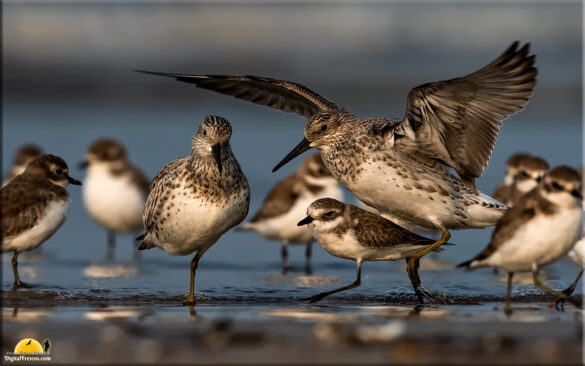
The great knot is a small wader. It is the largest of the calidrid species. The genus name is from Ancient Greek kalidris or skalidris, a term used by Aristotle for some grey-coloured waterside birds. Their breeding habitat is tundra in northeast Siberia. They nest on the ground laying about four eggs in a ground scrape. They are strongly migratory wintering on coasts in southern Asia through to Australia. This species forms enormous flocks in winter. The species is recorded in low numbers in western Alaska most years, and has occurred as a vagrant in British Columbia, Oregon, West Virginia, and Maine. These birds forage on mudflats and beaches, probing or picking up food by sight. They mainly eat molluscs and insects. This species has short dark legs and a medium-length thin dark bill. Breeding adults have mottled greyish upperparts with some rufous feathering. The face, throat and breast are heavily spotted black, and there are also some streaks on the rear belly. In winter the plumage becomes uniformly pale grey above. This species is classified as Endangered by IUCN.

The great knot is a small wader. It is the largest of the calidrid species. The genus name is from Ancient Greek kalidris or skalidris, a term used by Aristotle for some grey-coloured waterside birds. Their breeding habitat is tundra in northeast Siberia. They nest on the ground laying about four eggs in a ground scrape. They are strongly migratory wintering on coasts in southern Asia through to Australia. This species forms enormous flocks in winter. The species is recorded in low numbers in western Alaska most years, and has occurred as a vagrant in British Columbia, Oregon, West Virginia, and Maine. These birds forage on mudflats and beaches, probing or picking up food by sight. They mainly eat molluscs and insects. This species has short dark legs and a medium-length thin dark bill. Breeding adults have mottled greyish upperparts with some rufous feathering. The face, throat and breast are heavily spotted black, and there are also some streaks on the rear belly. In winter the plumage becomes uniformly pale grey above. This species is classified as Endangered by IUCN.
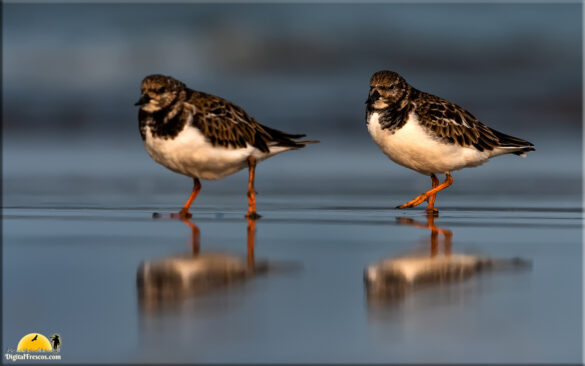
The ruddy turnstone is a small wading bird, one of two species of turnstone in the genus Arenaria. It is now classified in the sandpiper family Scolopacidae but was formerly sometimes placed in the plover family Charadriidae. It is a highly migratory bird, breeding in northern parts of Eurasia and North America and flying south to winter on coastlines almost worldwide. It is the only species of turnstone in much of its range and is often known simply as turnstone. In all seasons, the plumage is dominated by a harlequin-like pattern of black and white. Breeding birds have reddish-brown upper parts with black markings. The head is mainly white with black streaks on the crown and a black pattern on the face. The breast is mainly black apart from a white patch on the sides. Non-breeding adults are duller than breeding birds and have dark grey-brown upperparts with black mottling and a dark head with little white. The ruddy turnstone breeds in northern latitudes, usually no more than a few kilometres from the sea. The ruddy turnstone has a varied diet including carrion, eggs and plant material but it feeds mainly on invertebrates. Insects. It often flips over stones and […]
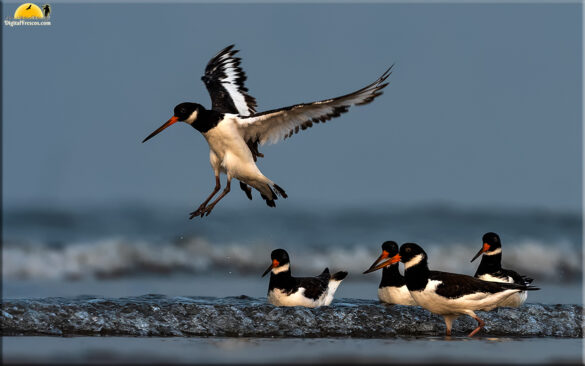
The Eurasian oystercatcher also known as the common pied oystercatcher, or palaearctic oystercatcher, or (in Europe) just oystercatcher, is a wader in the oystercatcher bird family. The oystercatcher is one of the largest waders in the region. It is 40–45 cm (16–18 in) long, the bill accounting for 8–9 cm (3.1–3.5 in), and has a wing-span of 80–85 cm (31–33 in). They are obvious and noisy plover-like birds, with black and white plumage, red legs and strong broad red bills used for smashing or prising open molluscs such as mussels or for finding earthworms. Despite its name, oysters do not form a large part of its diet. The bird still lives up to its name, as few if any other wading birds are capable of opening oysters at all. This is a migratory species over most of its range. The European population breeds mainly in northern Europe, but in winter the birds can be found in north Africa and southern parts of Europe. Although the species is present all year in Ireland, Great Britain and the adjacent European coasts, there is still migratory movement: the large flocks that are found in the estuaries of south-west England in winter mainly breed […]

The curlew sandpiper is a small wader that breeds on the tundra of Arctic Siberia. The genus name is from Ancient Greek kalidris or skalidris, a term used by Aristotle for some grey-coloured waterside birds. These birds are small waders, having a longer down-curved bill, longer neck and legs and a white rump. The breeding adult has patterned dark grey upperparts and brick-red underparts. In winter, this bird is pale grey above and white below, and shows an obvious white supercilium. Juveniles have a grey and brown back, a white belly and a peach-coloured breast. Of all shorebird species, the curlew sandpiper has the smallest breeding range in relation to its non-breeding range. After breeding these birds migrate south to Africa, Australasia or India. South Africa is at the southern limit of the migration path from Siberia, 15,000 km (9,300 mi) or 130° of latitude away. This wader is highly gregarious, and will form flocks with other calidrid waders, particularly dunlin. Despite its easterly breeding range, this species is regular on passage in western Europe, presumably because of the southwesterly migration route. This species is classified as Near Threatened by IUCN.
The little stint, is a very small wader. It breeds in arctic Europe and Asia, and is a long-distance migrant, wintering south to Africa and south Asia. It occasionally is a vagrant to North America and to Australia. The genus name is from Ancient Greek kalidris or skalidris, a term used by Aristotle for some grey-coloured waterside birds. The specific minuta is Latin for “small”. Its small size, fine dark bill, dark legs and quicker movements distinguish this species from all waders except the other dark-legged stints. It can be distinguished from these in all plumages by its combination of a fine bill tip, unwebbed toes and long primary projection. This species is classified as Least Concern by IUCN.
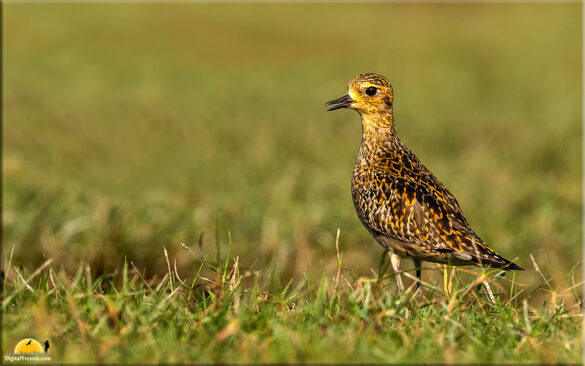
The Pacific golden plover (Pluvialis fulva) is a medium-sized plover. The genus name is Latin and means relating to rain, from pluvia, “rain”. It was believed that golden plovers flocked when rain was imminent. The 23–26 cm long breeding adult is spotted gold and black on the crown, and back on the wings. Its face and neck are black with a white border, and it has a black breast and a dark rump. The legs are black. In winter, the black is lost and the plover then has a yellowish face and breast, and white underparts. This wader forages for food on tundra, fields, beaches and tidal flats, usually by sight. It eats insects and crustaceans and some berries. The breeding habitat of Pacific golden plover is the Arctic tundra from northernmost Asia into western Alaska. It nests on the ground in a dry open area. It is migratory and winters in south Asia and Australasia. A few winter in California and Hawaii, USA. In Hawaii, the bird is known as the kōlea. They return to the same wintering territory each year, which allowed scientists in Hawaii to attach tiny light level geolocator devices to the birds and then retrieve […]
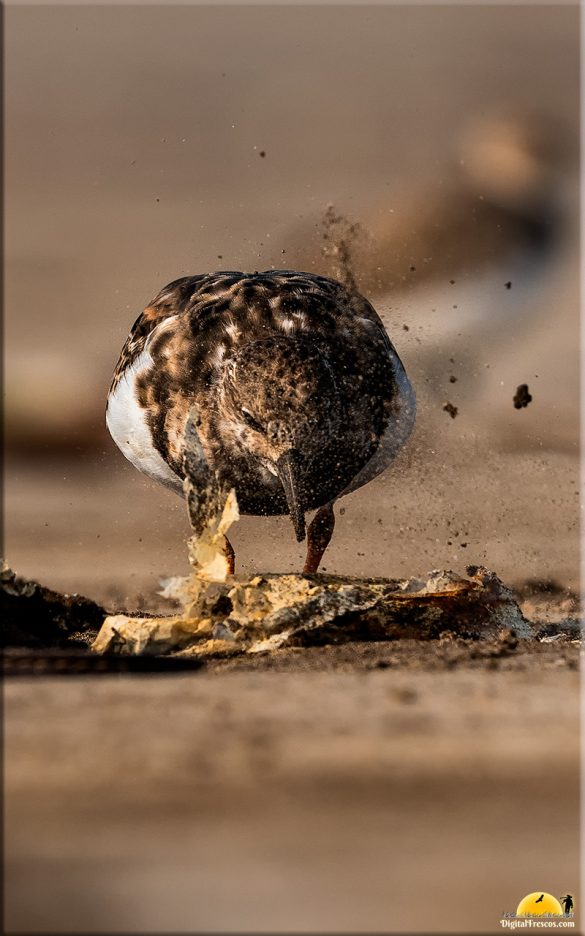
The ruddy turnstone is a small wading bird, one of two species of turnstone in the genus Arenaria. It is now classified in the sandpiper family Scolopacidae but was formerly sometimes placed in the plover family Charadriidae. It is a highly migratory bird, breeding in northern parts of Eurasia and North America and flying south to winter on coastlines almost worldwide. It is the only species of turnstone in much of its range and is often known simply as turnstone. In all seasons, the plumage is dominated by a harlequin-like pattern of black and white. Breeding birds have reddish-brown upper parts with black markings. The head is mainly white with black streaks on the crown and a black pattern on the face. The breast is mainly black apart from a white patch on the sides. Non-breeding adults are duller than breeding birds and have dark grey-brown upperparts with black mottling and a dark head with little white. The ruddy turnstone breeds in northern latitudes, usually no more than a few kilometres from the sea. The ruddy turnstone has a varied diet including carrion, eggs and plant material but it feeds mainly on invertebrates. Insects. It often flips over stones and […]
The lesser sand plover is a small wader in the plover family of birds. The spelling is commonly given as lesser sand-plover, but the official British Ornithologists’ Union spelling is “lesser sand plover”. t breeds above the tree line in the Himalayas and discontinuously across to bare coastal plains in north-eastern Siberia, with the Mongolian plover in the eastern part of the range; it has also bred in Alaska. It nests in a bare ground scrape, laying three eggs. This species is strongly migratory, wintering on sandy beaches in east Africa, south Asia and Australasia. In all plumages, it is very similar to greater sand plover. Separating the species may be straightforward in mixed wintering flocks on an Indian beach, where the difference in size and structure is obvious. The lesser usually has darker legs, a white forehead, and a more even white wing bar than the greater. This species is classified as Least Concern by IUCN.
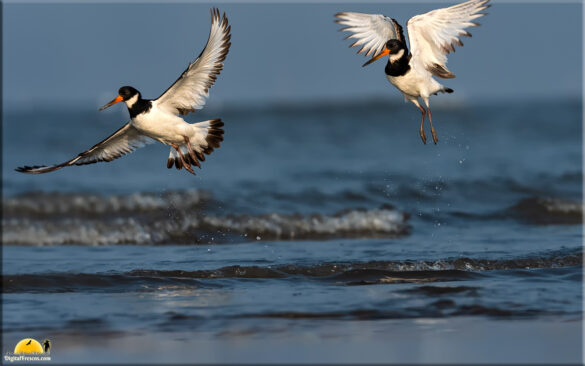
The Eurasian oystercatcher also known as the common pied oystercatcher, or palaearctic oystercatcher, or (in Europe) just oystercatcher, is a wader in the oystercatcher bird family. The oystercatcher is one of the largest waders in the region. It is 40–45 cm (16–18 in) long, the bill accounting for 8–9 cm (3.1–3.5 in), and has a wing-span of 80–85 cm (31–33 in). They are obvious and noisy plover-like birds, with black and white plumage, red legs and strong broad red bills used for smashing or prising open molluscs such as mussels or for finding earthworms. Despite its name, oysters do not form a large part of its diet. The bird still lives up to its name, as few if any other wading birds are capable of opening oysters at all. This is a migratory species over most of its range. The European population breeds mainly in northern Europe, but in winter the birds can be found in north Africa and southern parts of Europe. Although the species is present all year in Ireland, Great Britain and the adjacent European coasts, there is still migratory movement: the large flocks that are found in the estuaries of south-west England in winter mainly breed […]
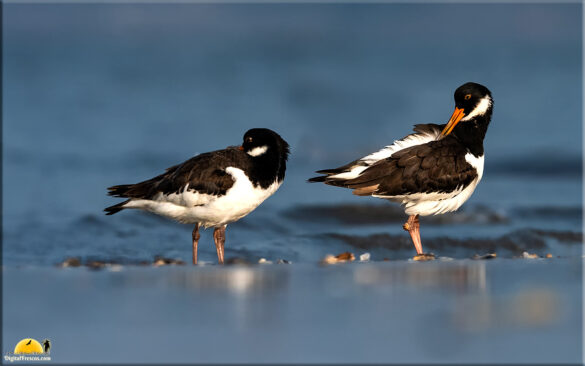
The Eurasian oystercatcher also known as the common pied oystercatcher, or palaearctic oystercatcher, or (in Europe) just oystercatcher, is a wader in the oystercatcher bird family. The oystercatcher is one of the largest waders in the region. It is 40–45 cm (16–18 in) long, the bill accounting for 8–9 cm (3.1–3.5 in), and has a wing-span of 80–85 cm (31–33 in). They are obvious and noisy plover-like birds, with black and white plumage, red legs and strong broad red bills used for smashing or prising open molluscs such as mussels or for finding earthworms. Despite its name, oysters do not form a large part of its diet. The bird still lives up to its name, as few if any other wading birds are capable of opening oysters at all. This is a migratory species over most of its range. The European population breeds mainly in northern Europe, but in winter the birds can be found in north Africa and southern parts of Europe. Although the species is present all year in Ireland, Great Britain and the adjacent European coasts, there is still migratory movement: the large flocks that are found in the estuaries of south-west England in winter mainly breed […]
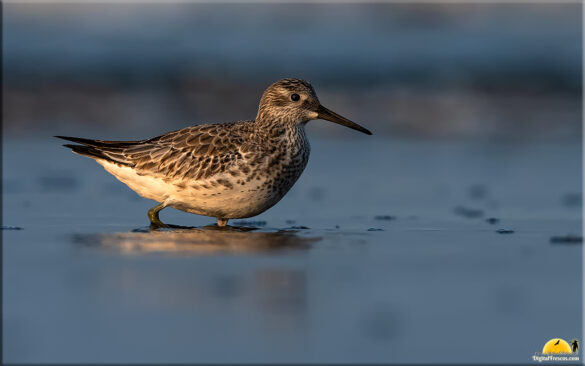
The great knot is a small wader. It is the largest of the calidrid species. The genus name is from Ancient Greek kalidris or skalidris, a term used by Aristotle for some grey-coloured waterside birds. Their breeding habitat is tundra in northeast Siberia. They nest on the ground laying about four eggs in a ground scrape. They are strongly migratory wintering on coasts in southern Asia through to Australia. This species forms enormous flocks in winter. The species is recorded in low numbers in western Alaska most years, and has occurred as a vagrant in British Columbia, Oregon, West Virginia, and Maine. These birds forage on mudflats and beaches, probing or picking up food by sight. They mainly eat molluscs and insects. This species has short dark legs and a medium-length thin dark bill. Breeding adults have mottled greyish upperparts with some rufous feathering. The face, throat and breast are heavily spotted black, and there are also some streaks on the rear belly. In winter the plumage becomes uniformly pale grey above. This species is classified as Endangered by IUCN.